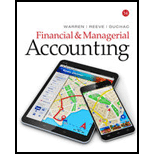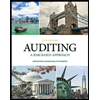
A.
Identify and explain the five elements of internal control.
A.
Explanation of Solution
Internal Control: Internal control refers to the policies, and plans of the business organization along with other measures with a view to safeguard its assets, encourage the employees to adhere to the plans, to improve on the operational efficiency, and to ensure correct and reliable accounting information. Internal control is a process which ensures continuous reliability of accomplishment of a company’s objectives, related to operations, financial reporting, and in conformity with laws and regulations.
Five elements of internal control:
- Control Environment: Control Environment refers to the attitude of top brass of the company or the corporate culture. The top brass of the company must set the tone to improve the morale for rest of the employees of the business.
- Risk assessment: The business must be able identify the risk associated with it, and accordingly use the internal control to safeguard its assets and ensures fairness in presentation in accounting information.
- Control procedures: The objective of setting the control procedure is to ensure that the business achieves its objectives.
- Monitoring controls: The internal control used in the business is being monitored by the internal auditors who are hired by the business, to ensure that the employees are adhering to the policies of the business and running the operations efficiently. The external auditors on the other hand ensures that the business accounting records are being maintained in accordance with the Generally Accepted Accounting Principles (GAAP).
- Information and communication: Information and communication system is important for a business and hence only authorized persons should be allowed the access to the confidential accounting information. Approvals are also should be made mandatory for the transactions by the
control system.
B.
Explain the importance of internal control.
B.
Explanation of Solution
When the elements of internal control are considered, one element of internal control is not important than other. In order to have an effective internal control, all five elements are considered to be necessary.
Want to see more full solutions like this?
Chapter 7 Solutions
Financial & Managerial Accounting 14th Ed. W/ PAC LMS Intg CNOWv2 2S
- Computer Haven sells laptops. During June 2021, it sold 320 laptops at a $1,650 average price each. The June 2021 budget included sales of 350 laptops at an average price of $1,550 each. Compute the sales price variance and the sales volume variance for June 2021.arrow_forwardWhat are the total product cost for the company?arrow_forwardHardy Technologies reports that at an activity level of 6,800 machine-hours in a month, its total variable inspection cost is $320,000 and its total fixed inspection cost is $150,000. What would be the average fixed inspection cost per unit at an activity level of 7,100 machine-hours in a month? Assume that this level of activity is within the relevant range.arrow_forward
- Need help answering question B? Negus Enterprises has an inventory conversion period of 55 days, an average collection period of 42 days, and a payables deferral period of 20 days. Assume that cost of goods sold is 80% of sales. Assume a 365-day year. Do not round intermediate calculations. A. What is the length of the firm's cash conversion cycle? Round your answer to the nearest whole number. 77 days B. If annual sales are $4,635,500 and all sales are on credit, what is the firm's investment in accounts receivable? Round your answer to the nearest dollar. $ C.) How many times per year does Negus Enterprises turn over its inventory? Round your answer to two decimal places. 6.64arrow_forwardI need the correct answer to this general accounting problem using the standard accounting approach.arrow_forwardPlease provide the correct answer to this general accounting problem using accurate calculations.arrow_forward
- Provide accounting answer pleasearrow_forwardHow much will cypress need to borrow during December?arrow_forwardThe actual cost of direct materials is $37.50 per pound, while the standard cost per pound is $35.25. During the current period, 5,200 pounds were used in production. What is the direct materials price variance?arrow_forward
 Cornerstones of Financial AccountingAccountingISBN:9781337690881Author:Jay Rich, Jeff JonesPublisher:Cengage LearningPrinciples of Accounting Volume 1AccountingISBN:9781947172685Author:OpenStaxPublisher:OpenStax College
Cornerstones of Financial AccountingAccountingISBN:9781337690881Author:Jay Rich, Jeff JonesPublisher:Cengage LearningPrinciples of Accounting Volume 1AccountingISBN:9781947172685Author:OpenStaxPublisher:OpenStax College Auditing: A Risk Based-Approach (MindTap Course L...AccountingISBN:9781337619455Author:Karla M Johnstone, Audrey A. Gramling, Larry E. RittenbergPublisher:Cengage Learning
Auditing: A Risk Based-Approach (MindTap Course L...AccountingISBN:9781337619455Author:Karla M Johnstone, Audrey A. Gramling, Larry E. RittenbergPublisher:Cengage Learning


